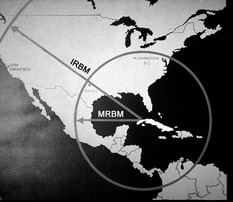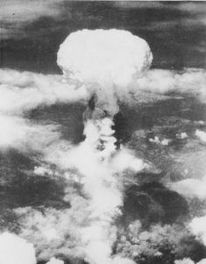Brief Summary

On October 14, 1962, an American spy plane was able to show clear evidence that Cuba was building a offensive nuclear facitliy, with aid from the Soviet Union. Nikita Khrushchev was responsilbe for this doing, his thought was that the location would help counter America's nuclear location in Turkey. A week later the Executive Committee of the U.S. National Security Council came up with a response, to "quarantine" Cuba. They couldn't blockade because that is an act of war. On October 22 , President Kennedy made a speech on national television to inform the nation of the missiles in Cuba. The world waited in anticipation to see if the ship would try to pass the " quarantine", as the Soviet ships near the line they changed couse back to Russia. President Kennedy and Khrushchev stayed in contact trying to defuse the situation. In the end they both agreed to dismantle the nuclear missiles site that they each had, ending the crisis.
Impact

The world learned a simple lesson about nuclear diplomacy. That the whole situation could have been avoided with open communication. That is why there was an installation of an emergency telephone hotline between Washington, D.C., and Moscow in 1963 which is to help avoid any misunderstandings in the event of another crisis. It also brought in an era of control arms which brought around the Nuclear Test Ban Treaty an agreement not to test nuclear weapons in the atmosphere, in the ocean, or in outer space. The treaty was first signed on August 5, 1963.
Photos:
https://www.cia.gov/library/center-for-the-study-of-intelligence/csi-publications/csi-studies/studies/vol46no1/CubaMap1b_w.jpg
http://i1-news.softpedia-static.com/images/news2/How-Did-the-First-Atomic-Bomb-Explode-2.jpg
Text Information:
Hastedt, Glenn. "Cuban Missile Crisis." Encyclopedia of American Foreign Policy.
Carlisle, Rodney P. "Limited Test Ban Treaty." Encyclopedia of the Atomic Age. New York
https://www.cia.gov/library/center-for-the-study-of-intelligence/csi-publications/csi-studies/studies/vol46no1/CubaMap1b_w.jpg
http://i1-news.softpedia-static.com/images/news2/How-Did-the-First-Atomic-Bomb-Explode-2.jpg
Text Information:
Hastedt, Glenn. "Cuban Missile Crisis." Encyclopedia of American Foreign Policy.
Carlisle, Rodney P. "Limited Test Ban Treaty." Encyclopedia of the Atomic Age. New York
By : Andrew and Chris
